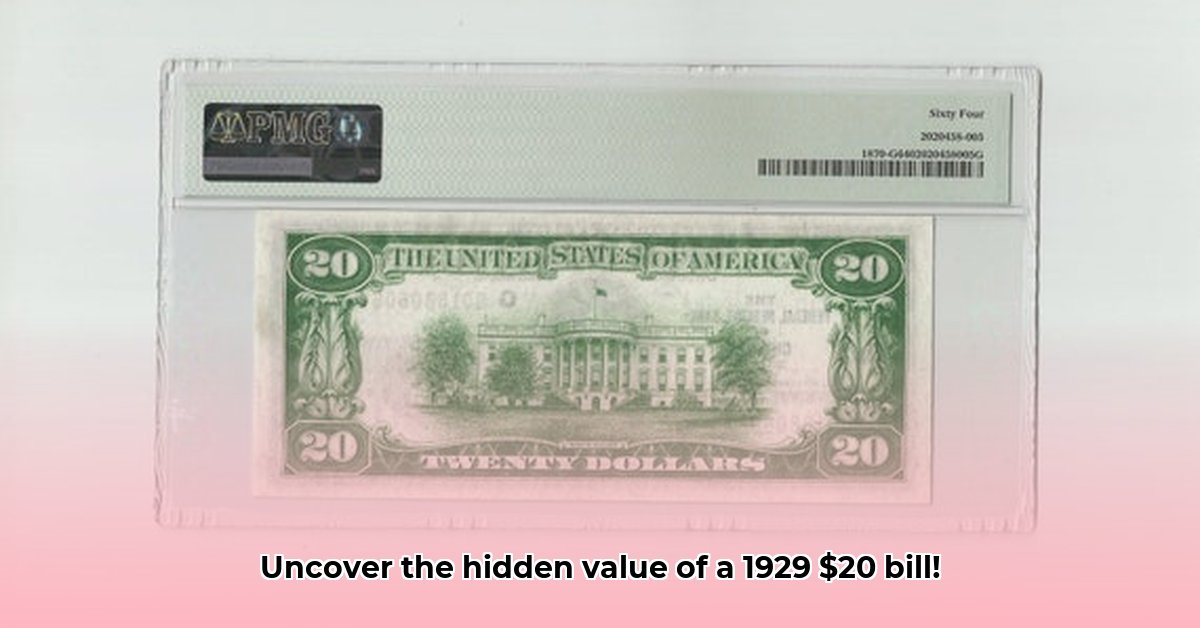
This guide provides a comprehensive approach to assessing the value of a 1929 twenty-dollar bill, catering to both novice and experienced collectors. We'll explore the factors influencing value, including bill type, condition, and unique features, culminating in actionable steps for accurate valuation. For more information on other 1920s bills, check out this guide on 1920s currency.
Understanding Your 1929 Twenty-Dollar Bill
Before diving into valuation, it's crucial to understand the nuances of 1929 twenty-dollar bills. Two main types exist: Federal Reserve Notes and National Bank Notes. Federal Reserve Notes, issued by the Federal Reserve System, are generally more common. National Bank Notes, issued by individual banks before the Federal Reserve's dominance, are significantly rarer and thus, more valuable. This distinction is paramount in determining your bill's potential worth. Did you know that the rarity of a National Bank Note can increase its worth exponentially?
Condition: The Cornerstone of Value
The condition of your bill profoundly impacts its value. Numismatists employ the Sheldon Scale (1-70) to grade banknotes, with higher grades indicating better condition and consequently, higher value. A pristine, uncirculated bill (graded 65 or higher) commands a significantly higher price than a well-worn example. Carefully examine your bill for imperfections, including:
- Tears and creases: Even minor imperfections reduce value.
- Fading and discoloration: Color preservation is crucial.
- Handling marks: Scratches, stains, and blemishes negatively impact grade.
- Centering: Off-center printing lowers value.
Unique Features: Hidden Treasures
Beyond overall condition, specific characteristics can dramatically boost a bill's value. These include:
- Low serial numbers: Bills with serial numbers starting with multiple zeros or low digits are highly sought after. These are often referred to as "low-number" bills and can substantially increase the value of the note.
- Star notes: A star (*) replacing a damaged digit in the serial number signifies a replacement note from an original sheet, adding inherent rarity.
- Unique signatures: The signatures of particular bank officials can enhance a bill's desirability.
- Printing variations: Unusual printing errors or quirks can increase collectibility and value.
These elements can dramatically impact a bill's value. Have you checked your bill for any of these characteristics?
Assessing Your Bill: A Step-by-Step Guide
To determine your 1929 twenty-dollar bill's value, follow these steps:
Identify the type: Determine if it's a Federal Reserve Note or a National Bank Note, a critical first step in valuation. This will dictate your next steps considerably.
Assess condition: Thoroughly examine the bill's condition using a grading reference like the Sheldon Scale. Photographing the bill from multiple angles can help highlight potential flaws or unique features.
Identify unique features: Carefully examine the serial number for low numbers or star notes. Note any unusual signatures or printing variations.
Conduct market research: Consult online resources (use with caution, always cross-reference) and auction results to compare your bill to similar examples. Remember to account for variations in condition and unique features.
Seek professional appraisal: For high-value bills, a professional numismatist's assessment provides accurate authentication and valuation. This final step is always recommended to validate the value.
Market Outlook and Considerations
While a common 1929 twenty-dollar bill might only fetch a few dollars, a rare National Bank Note in excellent condition could command hundreds, even thousands. However, remember that market values fluctuate based on supply and demand. Staying informed about market trends through reputable numismatic publications and online communities is crucial. This dynamic landscape necessitates consistent monitoring of recent sales and market trends.
Potential Pitfalls and Mitigation
| Risk Factor | Mitigation Strategy |
|---|---|
| Forgery/Counterfeiting | Professional authentication is essential. Verify serial numbers and compare to reputable examples. |
| Overvaluation/Mispricing | Thorough research and multiple appraisals from reputable sources are crucial. |
| Market Volatility | Diversify your collection to minimize risk. |
By following this guide and taking appropriate precautions, you can confidently assess the value of your 1929 twenty-dollar bill and navigate the exciting world of currency collecting. Remember, patience and thorough research are key to maximizing the return on your investment.